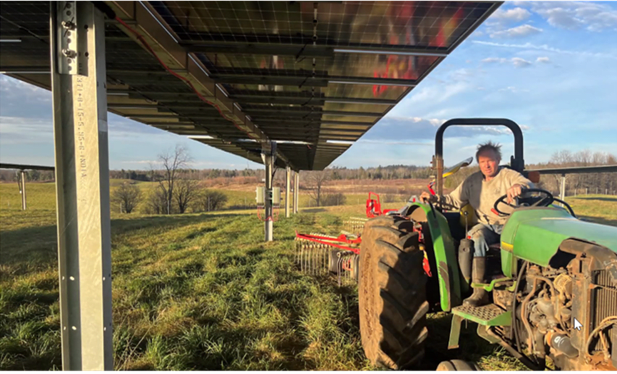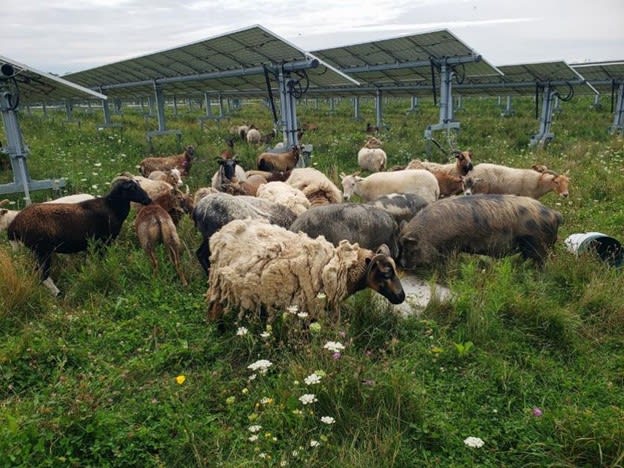The Future of Farming and Energy: Why Agrivoltaics is a Game Changer
This blog is part of our series spotlighting leaders in the pursuit and development of Responsible Renewables projects. This series is being hosted in collaboration with Schneider Electric and Korn Ferry. For a background on responsible renewables, we encourage you to start with the introductory blog, which explores the issues and opportunities.
In our latest Responsible Renewables series, we explore Agrivoltaics—a fusion of agriculture and solar power—integrating agriculture with solar power to create sustainable, dual-use landscapes that benefit both the environment and local communities.
Imagine a future where America’s farmlands don’t just grow food but also harvest the sun’s energy. That’s exactly what Agrivoltaics—a fusion of agriculture and solar power—is making possible. To unpack this, we sat down with Ethan Winter from American Farmland Trust (AFT), an organization that has been at the intersection of agriculture and environmental sustainability for over 40 years.
Meet Ethan Winter.

.
Ethan Winter is the National Smart Solar Director at American Farmland Trust (AFT). His role focuses on balancing farm viability, clean energy, resource protection, and community empowerment to safeguard America’s farmland.
.
What can you tell us about AFT and its mission?
Ethan Winter: AFT works to protect America’s farmland, promote sustainable farming practices, and keep farmers farming to ensure we have a next generation of farmers. Agrivoltaics is an emerging practice that sits at the sweet spot of these goals by integrating solar energy with working farms in a way that benefits both farmers and the planet.
 Photo: Clear Path Energy (Hay production / community solar project NY)
Photo: Clear Path Energy (Hay production / community solar project NY)
Why is Agrivoltaics such a game changer? Can you explain the three pillars of smart solar?
Ethan Winter: Absolutely. The three pillars of smart solar are:
- Ensuring Farm Viability – With rising costs, extreme weather, and thin margins, farming is tough, especially for smaller producers. The reality is, most small and mid-sized farms didn’t make a profit last year. Long term solar leases can provide farmers with a stable source of diversified farm income, helping them weather unpredictable markets and climate conditions as well as to re-invest in their farm business.
- Safeguarding Soils – Not all farmland is created equal. AFT has mapped the most productive, versatile, and resilient (PVR) soils across the country to better understand the distribution of – and threats to – our most productive ground for growing food. While commercial and residential development permanently converts farmland, solar installations can be a temporary use, preserving the land’s potential for future generations. Under a business-as-usual scenario where we're already losing farmland mostly to commercial and residential development, solar development on farmland could become a potential accelerator for farmland loss. There are both opportunities and challenges, and that’s why we're so interested in this.
- Supporting Renewable Energy – The U.S. energy demand is skyrocketing, driven by data centers, AI, and electrification. Agrivoltaics allows us to expand clean energy without sacrificing agricultural production—if done right, this is a win-win for sustainability. It's about doing this with an intentional design and direct engagement with farming communities who are interested in strategies to be more financially resilient. More energy and agricultural stakeholders are recognizing the potential, and we're seeing some really interesting examples of this in applied research and in applications around the world.
Farmers seem to be open to solar, but it has to align with their interests and goals. What have you found in your studies?
Ethan Winter: One of the most exciting findings from a recent study conducted by the Solar and Storage Industries Institute is that 70% of surveyed farmers are open to utility scale solar on their land if it could include a dual-use component—that is, if they or others can still farm alongside it. Similarly, 80% of solar developers expect Agrivoltaics to be part of their future projects. AFT’s farmer surveys have also shown a relatively sizable proportion of farmers who are interested in agrivoltaics – an important gap we are working on is to provide information, guidance and policy recommendations to enable this to happen on a broader scale.
What does this look like on the ground?
Ethan Winter: Imagine rows of solar panels spaced wide enough for tractors to pass through, panels raised higher to allow for grazing livestock, or high value specialty crops benefitting from growing in the partial shade of solar arrays. The work right now is answering the right research questions, having the correct policy tools, developing standards and supporting farmer technical assistance so farmers can navigate these questions about agricultural production in and around the solar systems.
What’s at stake if we don’t integrate Agrivoltaics?
Ethan Winter: We’re looking at major risks:
- Global food demand is expected to rise 50% by 2050.
- Energy demand is growing exponentially due to digital infrastructure needs. According to the Group Next Move Strategy Consulting, the renewable energy market will reach over two trillion U.S. dollars by 2030.
- Climate volatility is already making farming harder and stressing local food systems.
Without smart solutions like Agrivoltaics, we risk permanently losing farmland, increasing food insecurity, and deepening rural opposition to renewable projects. The challenge isn’t just generating more energy; it’s ensuring that energy solutions don’t come at the cost of food production and rural livelihoods. These are big megatrends that are all pointing towards the need for an integrated approach where regenerative agriculture and solar can work together. Luckily, this presents an opportunity for an enterprising new generation of farmers who want to do things differently than their parents or grandparents. For example, sheep grazing around solar projects tends to be of interest for producers in their 30s and 40s, which indicates a new generation of entrepreneurs who are interested in working around solar. We are excited to see agrivoltaics expand beyond sheep grazing to specialty crops and potentially to cattle, as project designs are adapted.
How can corporate energy buyers accelerate Agrivoltaics?
Ethan Winter: Corporate energy buyers have immense influence. They can:
- Send Market Signals – Enter into Long-term REC Agreements or Virtual Power Purchase Agreements (vPPAs) with Agrivoltaics projects can provide financial certainty for both farmers and developers.
- Support Policy and Standards – AFT recently introduced policy recommendations for a standardized definition of Agrivoltaics to prevent greenwashing and ensure real benefits for farmers. Several states are actively developing research and demonstration programs, financial incentives, and solar procurement guidelines to encourage agrivoltaics and reduce conflicts with farm communities. In due diligence processes, confirm that the project meets certain thresholds.
Can you share a success story that highlights the potential of Agrivoltaics?
Ethan Winter: One initiative I’m excited about is AFT’s new Prosperity Partners program, which directly connects developers and corporate buyers with AFT to craft farmer-centered solar solutions. Prosperity Partners will fill an important gap between the energy and agricultural sectors, helping to advance projects and portfolios that balance farm viability, solar energy production, and community benefits. We believe corporate energy buyers will be increasingly interested in meeting their growing energy needs through projects that align with their brand and sustainability goals.
 Photo: United Agrivoltaics, NY
Photo: United Agrivoltaics, NY
Final thoughts?
Ethan Winter: Agrivoltaics isn’t just an idea—it’s a solution we can implement today. Whether you’re a farmer, a corporate buyer, or a developer, you have a role to play. Let’s push for solutions that sustain our farms and rural communities while meeting our current and future energy needs. Email me if you’d like to keep the conversation going.
Subscribe to our mailing list to join us as we expand on the topic of responsible renewables in a blog series that will feature conversations shaping the future of responsible renewables. Each month, we will publish a new blog spotlighting another important voice working to address responsible renewables, including developers, corporate buyers, community members, and NGOs.